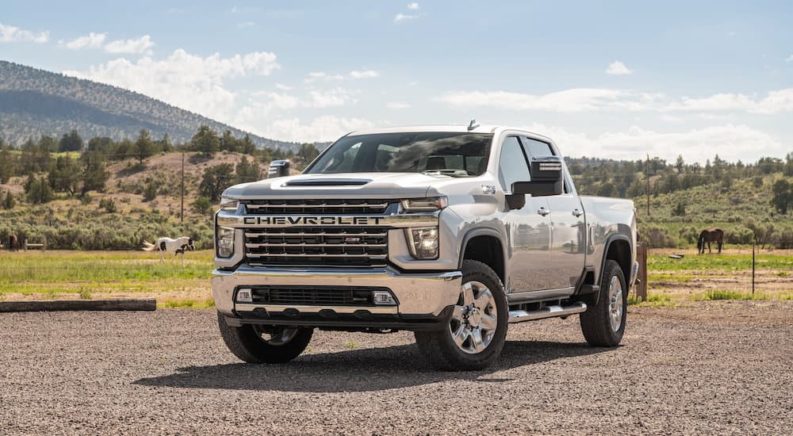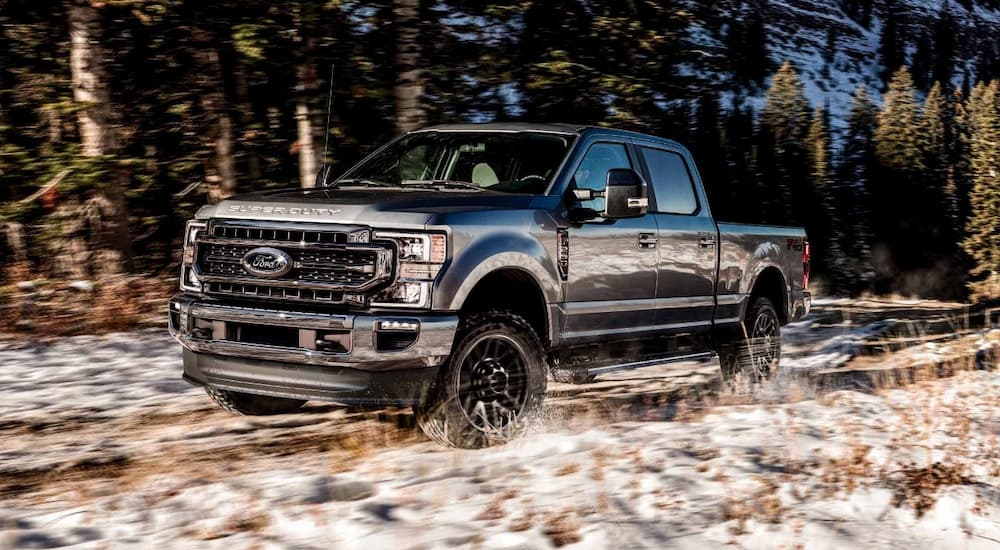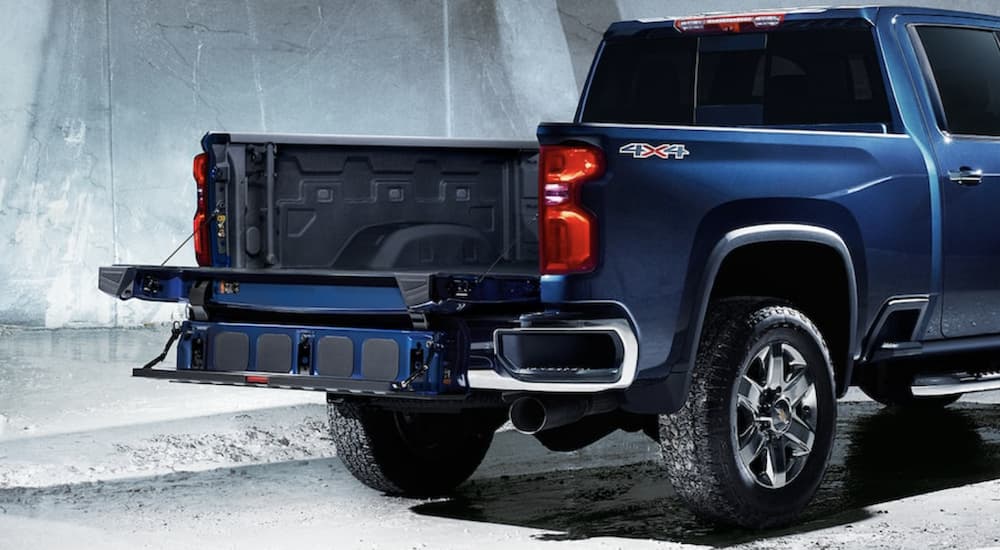Chances are, if you’re looking at a truck that has “HD” as a part of its name, you have some serious work to accomplish. Whether it’s hauling, towing, trailering, or just getting an honest day’s job taken care of, these vehicles are built for what you need. Deciding which one is the best within the industry isn’t always a clear-cut choice. This is especially true when two manufacturers with a long-standing rivalry both offer engines potent enough to accomplish tasks that others might find too difficult or even impossible. The choice is made even more difficult when those rival trucks are the 2022 Chevy Silverado and the 2022 Ford F-250.
Ford and Chevy have been attempting to outperform one another for well over a century. When it comes to the massive machines that are meant to move earth and carry the burden of a heavy workload, we’re once again examining what both manufacturers have to offer. But rather than hold a magnifying glass to every single square inch, we’re going to focus our attention on the engines that make these machines perform. These are the motors that make them monsters, and the competition that to this day has no end in sight.
Built Between a Rock and a Tough Place
Both manufacturers have utilized clever slogans in the past to get across the virtues and advantages of their respective brands. Ford claims their vehicles are “built Ford tough,” whereas Chevy’s slogan for many years was “like a rock.” Luckily, marketing slogans aren’t a determining factor in a vehicle’s quality. Both the Ford F-250 and the Silverado 2500 have engine options that embody both slogans, so we’ll begin with the introductory offerings from both—to see where the advantages lie.
Ford’s introductory offer is a 6.2-L V8, known among aficionados of the brand as the “Boss.” First introduced in 2010, the engine, which originally was designed for the Ford F-150 Raptor, has found success as the powerhouse behind the Ford F-250. With over a decade of use under its belt, it’s more than apparent that the engine had earned its stripes. Equipped with a six-speed automatic transmission, the Boss generates 385 horsepower and 430 lb-ft of torque. 15,800 lbs towing capacity at its heaviest-equipped isn’t too shabby, either—though this number varies upon which model truck and drivetrain you’re equipped with.
While Ford’s offering is impressive and has the experience, Chevy’s standard newcomer breaks the mold as far as expectations are concerned. First introduced in 2020, the 6.6-L V8 is one of GM’s most effective engines, and it comes standard on the Silverado 2500.
Much like the Ford Boss, Chevy’s gasoline-powered engine is equipped with a six-speed automatic transmission. However, many of the direct similarities end there. Under the hood of every Silverado 2500 is the ability to generate 401 horsepower and 464 lb-ft of torque. Outperforming the wily veteran, GM once again asserts its dominance. A max towing capacity of 17,370 lbs tips the scales even further.
My final verdict on these two engines sides with Chevy and GM. While GM’s offering is still a newer engine, the problems reported by many with Ford’s Boss are too prominent to overlook. Many have told of issues with oil, such as high rates of consumption and leaks. This might be attributed to the low cost/high production quota of the engine. While it costs thousands less, you sometimes get what you pay for.
Aside from the issues that the Ford Boss engine presents with oil usage, many reported valve spring issues, which could have the possibility to make the engine misfire while in use. The only consistent problem Chevy’s introductory engine has presented is a knocking sound. Otherwise, the engine has received acclaim from both critics and drivers alike.
Diesel Power and Its Dynamic Results
A common factor among many pickup trucks today is the availability of diesel engines. While these still run on fuel that has a considerably thicker consistency than regular gasoline, I can assure you, this is NOT your daddy’s diesel engine. It was back in 1994 when Ford began to equip some of their vehicles with a turbocharged diesel engine, a trend that’s continued and only risen in popularity among many manufacturers. As one might expect, both Ford and Chevy have their own contributions to the diesel-fueled engine game.
First introduced in 2011 and given a series of upgrades for the 2020 model year, Ford’s diesel-powered, 6.7-L engine known as the “scorpion” is just as potent as its namesake might suggest. 475 horsepower and an impressive 1,050 lb-ft of torque are specs that anyone would find impressive and efficient. Like so many other diesel engines, both are produced at lower RPMs, specifically 2,800 and 1,600.
Of course, those aren’t the only numbers that can make jaws drop in awe. Capable of towing up to 22,800 lbs, Ford has pushed the limits of what diesel can accomplish. Like many of its competitors, Ford equips their diesel with a ten-speed transmission for ideal performance.
Because Chevy isn’t one to be outdone by any competitor, they bring their own brand of ingenuity to the forefront of their diesel offering. As a matter of fact, it’s almost impossible to mention the word “diesel” and not think of “Duramax” in the same sentence. GM’s turbocharged diesel offerings have been effective and potent at performing mammoth tasks.
Introduced for the 2017 model year, the 6.6-L Duramax Turbo-Diesel offers consumers formidable, accessible power. 445 horsepower and 910 lb-ft of torque are produced at the low engine RPMs of 2,800 and 1,600. The Duramax-equipped Silverado 2500 HD can tow 18,510 lbs. While this specification feels considerably less than Ford’s Scorpion engine, the Allison ten-speed transmission that comes equipped with the Duramax enables the engine to reach max tow ratings while in first gear.
Once again, I think that Chevy’s Duramax is the superior diesel engine. While the Ford “scorpion” diesel generates relatively impressive specs, the issues reported by consumers are once again too substantial to turn a blind eye to. The most notable of the issues that were reported is the injection pump, whose contamination can cause irreparable damage to the fuel system. While no engine is perfect by any means, and problems such as these are taken care of over time by the manufacturer, the cost (and inconvenience) of repairs is something to keep in mind.
Final Verdict on Superior Engines
Both Ford and Chevy have long been known for producing engines that not only perform exceedingly well, but last long amounts of time—going the extra distance for their owners. While the specs for each engine offering are often neck and neck with one another, I ultimately must go with GM’s engine offerings. Superior quality and lengthy lifespans always win out against horsepower and torque. The Duramax’s ability to tow massive amounts of weight while still in first gear is impressive, and I certainly recommend this powertrain to those who must tow or trailer on a nearly everyday basis. While the favorite brand is one of subjective choice, I hope you’ve enjoyed this objective look at the power that today’s pickups can muster for the working world.






